In a world where a potential customer’s first impression is formed within 2.8 seconds of visiting your website,1 design matters more than ever before.
From the apps on your smartphone to the sleeve around your coffee cup, the ever-connected world we live in is full of opportunities for brands to make a great first impression with a strong design.
If you want a job where you’ll be working on something different every day, thriving in a fast-paced environment and loving a creative challenge, a career in graphic design may be just for you. And the best news is that you don’t even need a degree to succeed, as long as your work is beautiful.
In this guide, you’ll learn how design has developed over the years, the various types of jobs designers undertake and the skills you’ll need to succeed in the industry.
Shall we?
What is graphic design?

TLDR: Graphic design is artwork that combines text and images (illustrations or photographs) in order to sell products or promote an idea.
Regardless of what field you’re in, graphic design skills are a huge asset.
If you’re good at graphic design, you can create corporate identity sets like logos and letterheads, printed materials like posters and packaging, digital assets like infographics and social media ads and much more. Whether you choose to specialize or generalize is up to you.
History of graphic design
The term “graphic design” was first coined by book designer William Addison Dwiggins in 1922, but the term didn’t catch on until the 1950s.2
Graphic design has existed for as long as people have been using visuals to communicate. In a sense, early humans painting scenes on the walls of caves could be considered the first examples of graphic designers.
The printing press led to the rise of commercial graphic design as we know it today. Using moveable type and intaglio printmaking techniques, printers could mass-produce newspaper advertisements, pamphlets and posters to be seen by a larger audience than ever before.
With industrialization leading to far more productive companies, there was a greater need for advertising to fuel the demand for mass-produced products. Products such as soda, soap and cigarettes competed for eyeballs with advertisements that gradually transitioned from text-heavy to image-heavy.
Since then, design has moved away from more extravagant, decorative styles toward more minimalistic and utilitarian styles. For instance, in the late 19th and early 20th centuries, typographic trends were modernized with the introduction of sans-serif fonts. The Bauhaus movement popularized a brand of minimalism in poster, architecture and furniture design that grew to mass production in mid-century America.
In the last half century, the modern discipline of graphic design has boomed to support a rise in consumerism. The computer revolutionized the field and shifted the primary medium for design from print to digital. The internet has grown into a global marketplace for designers, who can produce work for clients around the world.
All of these factors make it an exciting time to be a graphic designer.
8 types of graphic design
Graphic design is a far-reaching term that encompasses many types of design, depending on the desired product. Some designers specialize in multiple types of design, while others focus on just one.
Here are the eight most common types you’ll encounter when job hunting.
Branding and visual identity sets
If you’re imagining logos, stationery and business cards, you’re imagining correctly.
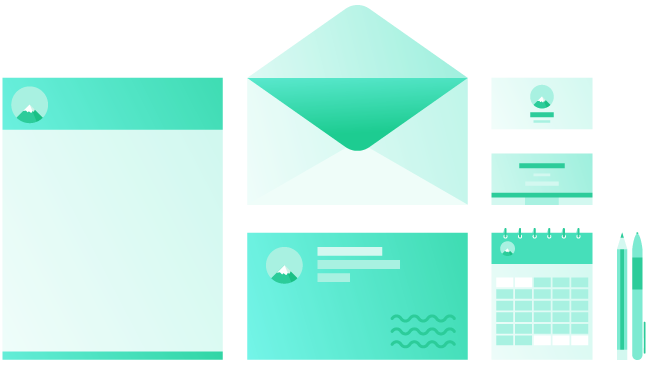
In the past, these materials were primarily designed with print in mind, but the market has become increasingly focused on digital branding more than anything. For example, logos must be designed for every type of screen people have today.
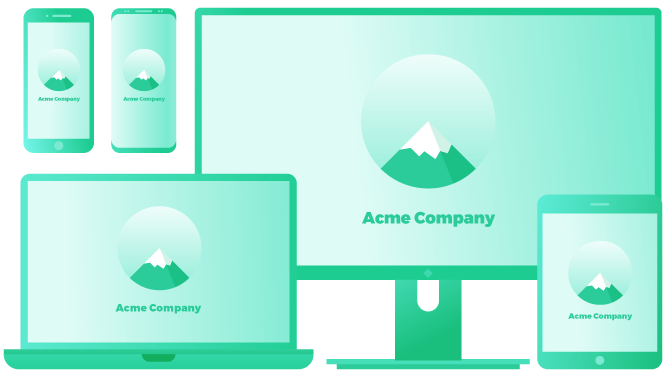
Marketing materials
Designers who focus on marketing and advertising materials, design promotional ads such as postcards, brochures and social media images.
These are often created in “campaigns” that span more than one media type. For example, the same series of Apple advertisements can likely be found in a magazine, on Facebook and on a massive billboard.
Illustrations
As the successor to woodblock and engraved prints from previous centuries, illustration involves any visual element created to accompany or clarify text. This form of graphic design can span many different types of media from drawing to computer illustration. There is a wide variety of different types of careers in illustration from medical or technical illustration to fashion illustration and concept art.
Photo editing

- 720p
- 540p
- 360p
- 0.50x
- 0.75x
- 1.00x
- 1.25x
- 1.50x
- 1.75x
- 2.00x
Photographs are often heavily modified to remove blemishes, correct lighting problems and add elements not found in an original photograph. If you’re working in the fashion industry – or any industry that relies heavily on photos – as a graphic designer, you need to be equipped with killer photo-editing skills.
Packaging
From wrappers to bags to custom-designed cardboard boxes, good packaging can make a product leap from the shelves. This type of graphic design hits consumers at the last stage of the buying cycle and plays a huge role in impulse purchases. In fact, one-third of consumers’ purchasing decisions are based on packaging alone.

Publishing
Thanks to the printing press, the publishing industry was born. It has dramatically changed since then, transforming from manual typesetting with individual metal characters to phototypesetting to desktop publishing. Even as publishing has gone fully digital, the ability to produce beautiful copy is still incredibly important.
Front-end design
We have front-end designers to thank for how things look on the web. Front-end designers create prototypes and comps of website designs, which are passed on to developers to implement. The job often requires basic web development skills like HTML and CSS.

Data visualization
While data visualization is a new specialization, it isn’t any less important. These designers turn complex information into easy-to-digest visuals, including infographics, charts, annual reports and diagrams.

You can find beautiful examples of data visualizations in publications like Bloomberg and The New York Times.
Must-have skills for graphic designers

Nobody tells this to people who are beginners; I wish someone told me. All of us, who do creative work, we get into it because we have good taste. But, there is this gap. For the first couple years, you make stuff, it’s just not that good. It’s trying to be good, it has potential, but it’s not. But, your taste, the thing that got you into the game, is still killer. And, your taste is why your work disappoints you. A lot of people never get past this phase; they quit. Most people I know who do interesting, creative work went through years of this. We know our work doesn’t have this special thing that we want it to have. We all go through this. And, if you are just starting out or you are still in this phase, you have to know it’s normal, and the most important thing you can do is do a lot of work. Put yourself on a deadline so that every week, you will finish one story. It is only by going through a volume of work that you will close that gap, and your work will be as good as your ambitions. And, I took longer to figure out how to do this than anyone I’ve ever met. It’s going to take a while. It’s normal for it to take a while. You’ve just gotta fight your way through.
Ira Glass
If you’re just starting out, your designs won’t likely impress you. Fortunately, this won’t always be the case. With a little time and effort, your design skills will improve and maybe even impress you someday.
With that being said, let’s dive into the seven must-have skills for graphic designers and how to sharpen them.
Creativity
What exactly is creativity? Put simply, creativity is “the act of turning new and imaginative ideas into reality.”
Most creative professionals will tell you that creativity is a core part of their craft – after all, it’s right there in the name! While technical skills are important, you won’t succeed in graphic design if you’re not creative.
While many people believe you’re either born creative or you’re not, the truth is that creativity can be learned, but only if you practice.
To get started, let’s discuss the top tactics for jumpstarting your creativity.
Build a creative environment
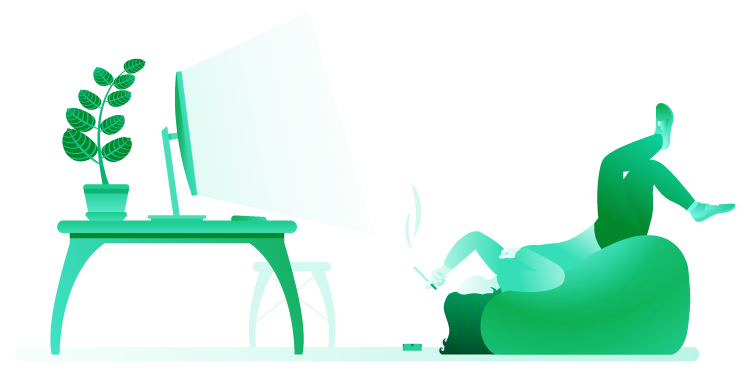
First, give yourself the space to be creative. If possible, create a space in your home that you use only for honing your craft.
Studies report that working at a messy desk and having a desk plant are ways to increase creativity.
It also helps if you plaster your office with various sources of inspiration.
Think laterally
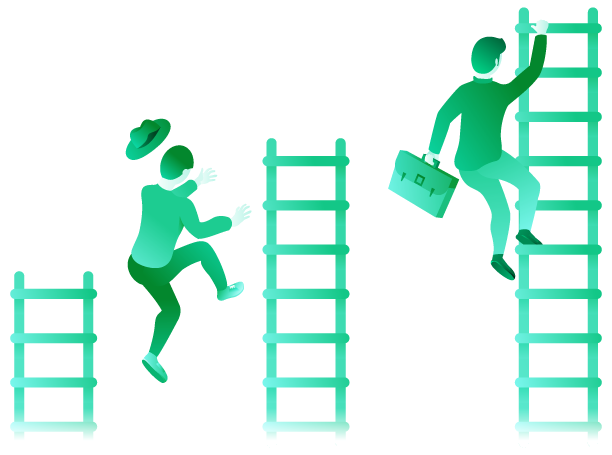
“Lateral thinking” is the process of solving a problem in an unexpected or non-obvious way. Challenging the conventions of the industry or just the assumptions you carry with you when trying to solve a problem can lead to innovative new ideas.
To think laterally about a problem, start coming up with creative new ideas; force yourself to acknowledge the assumptions you have.
List out those assumptions, and question them.
Why is it done this way? What if this weren’t true?
Sometimes, it helps to shift your perspective.
How would a scientist solve this problem? How would your mother solve this problem?
Asking these questions can help spur new connections between unrelated ideas, inspiring creativity.
Ideate intentionally

Don’t you love that feeling of being struck by an incredible idea? Such epiphanies aren’t common, but they are a great driving force for innovation. If only you could make that happen more often.
Well, guess what? You can! You don’t need to wait for the perfect idea to strike; you can systematically work to generate the perfect idea.
If you have a system in place for collecting ideas as they strike you, whether it’s an Evernote document or a Trello board, awesome! That’s step one.
Step two: consume information that is related, or not, to your problem. Over time, you’ll know which sources of inspiration work best for you. Some of my favorites are Reddit’s r/InternetIsBeautiful, Awwwards, Dribbble and Pinterest.
After that, you need to give your ideas time to percolate. Put your problem away for a little while. You are a problem solver, though, so it will still be working away in the back of your mind, manipulating the pieces and trying to make new ideas fit.
Record these new connections as they strike you and keep repeating the process until you have the best solution.
Find your flow
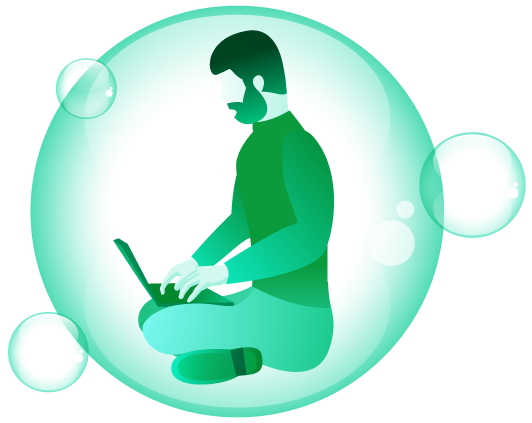
We live in a super-connected world, where you can reach anyone at almost any time. But, if you are like most people, your best work comes from the times you’ve disconnected and given yourself space to really dig into a problem.
If you create your best work when you are alone and have room to deeply consider a problem, why would you allow yourself to remain interruptible at any second?
Many of our time’s greatest creative thinkers wrote about the value of disconnecting to produce better work. In the famous words of a famous artist:
Without great solitude, no serious work is possible.
Picasso
Create space for yourself to find your flow: the state where you can achieve absolute focus on what you are working on.
To do that, give yourself large chunks of uninterrupted time, perhaps following a maker’s schedule where you give yourself at least half the day to devote to deep work.
Turn off your cell phone, silence Slack and sign out of Gmail, so you don’t get notifications – this is important because if you’ve worked carefully to get yourself into a flow state, why would you allow unimportant messages shatter it?
Think inside the box

I know what you’re thinking: these are supposed to be ideas for how to be more creative, and you’re telling me to think inside the box?! Yes, I am.
Constraints and limitations can be some of the greatest drivers of creativity.
Note that these are different from assumptions – the things you just assume are constraints without a second thought – these are actual, unyielding limitations that we place on our work either due to the needs of the client or our own desire to test our strengths.
Some common constraints include: deadlines, fewer resources and changes in your environment.
For example, if you typically work in Photoshop, maybe you can force yourself to work in Sketch. Or, you may decide to challenge yourself to a 365-day project, where you create something every single day. This constant deadline can be a really motivating, creative change.
Slow down and smell the roses

If you want to become more creative, it is essential that you give yourself the time and the space to be creative.
There’s a reason that procrastinating and taking breaks can actually make you more creative. With more time to piece together ideas and odd tidbits of knowledge, you can come up with more novel solutions than if you immediately jump into your work.
Much of creative ideation involves simply trying things to see if they work.
Maybe you will pursue one idea for a day or a week and see where it goes. Maybe a chat with a friend over dinner will plant the seed of inspiration that fuels your next big epiphany. The important thing to remember is that your works in progress are always chugging away in the background of your mind, so even if you aren’t working on them, you’re thinking about them.
There are a few tricks to give yourself more space to be creative – even a few that go against common productivity advice.
Chip away at your projects in small bursts as the inspiration strikes, then put them away to ponder during your commute or morning shower.
Take a break or end the day in the middle of a design instead of at a “stopping point” because picking up something unfinished can sometimes lead to new ideas. Whatever you do, for your most important projects, it is important to allow yourself the time to explore different solutions.
Use creative exercises and prompts
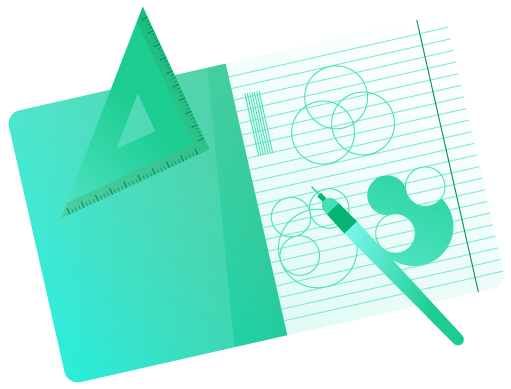
If all else fails, there’s always brainstorming, right?
Actually, there are other idea-generating exercises that are quicker and more reliable than staring at a blank page.
One of my favorite creative exercises is forced association.
Forced association involves combining two different objects, concepts or ideas to create something new. In a way, you are putting a very specific kind of constraint on your problem.
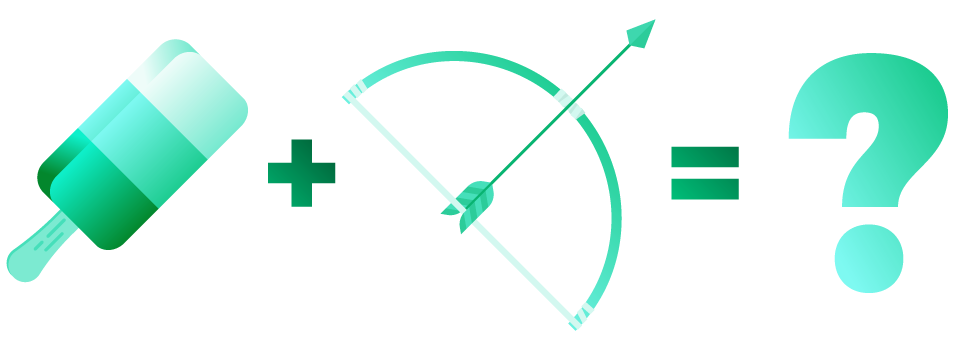
Another fantastic exercise is called, “Six Thinking Hats”.
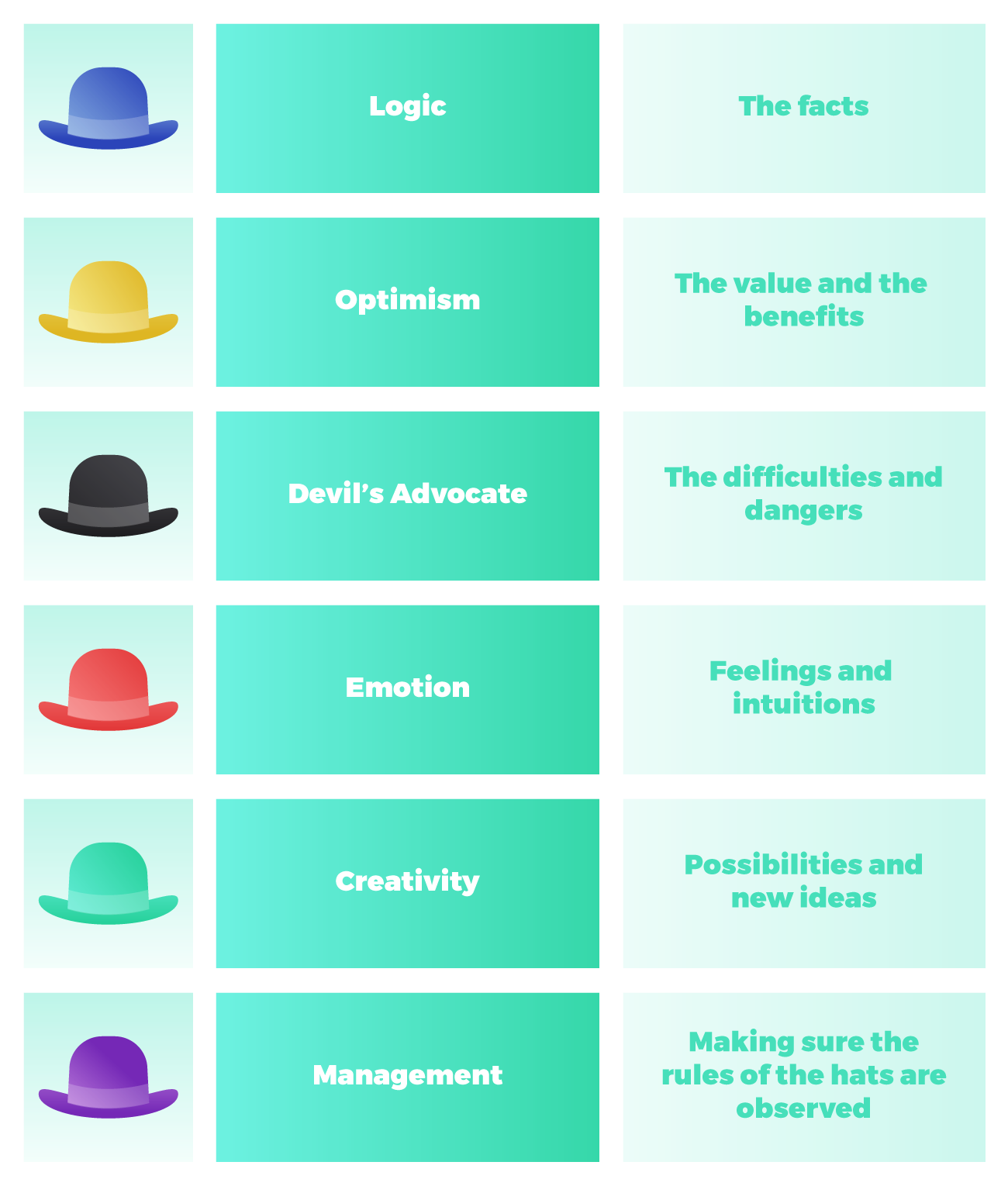
Six Thinking Hats was originally explored in the 1985 book of the same name by Edward de Bono. By looking at your problem “wearing” each of the six hats, you can begin to understand your problem from all angles. This can be particularly useful in group settings by getting everyone to wear the same hat at the same time, which leads to idea generation rather than disagreement.
All of the strategies above were designed to help you hone your creativity. Feel free to try them one at a time or in any combination to boost your creativity.
Problem solving
Going hand-in-hand with creativity, problem-solving is an important skill to develop if you want to become a graphic designer.
Every day, graphic designers solve problems for their clients, such as how to imply a particular marketing message without stating it outright and how to appeal to a certain demographic.
These challenges require a designer to take a problem and spin it in different ways and test alternative theories until they find a solution.
With experience, designers can develop a type of problem-solving intuition. Thus, as the cliché goes, “practice makes perfect”.
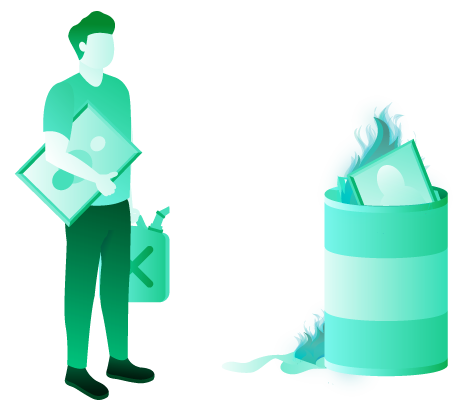
One way to develop this skill is to focus on the solution rather than the problem.
Of course, you first have to deeply understand a problem and how it affects the user in order to be able to solve it well. Once you do, switch your focus. Doing so will keep your subconscious searching for novel solutions rather than drowning in the negativity surrounding a single-minded emphasis on what is going wrong.
Communication
Regardless of whether you work from home or in an office, you have to be a good communicator.
Communication has two sides: speaking and listening. To be a strong communicator, you must be good at both.
As a graphic designer, you are the translator between your client’s expectations and the work you deliver. If you lack strong communication skills, there will likely be a gap between what the client expects and what you deliver.
Typography
Moving away from soft skills, let’s talk typography – an essential, hard skill for every designer.
Typography is the art of arranging type in a legible and appealing way.
While the skill requires a keen eye for design, there’s a scientific side to it, as well. For example, in some contexts, serif fonts are more legible than sans-serif and vice versa.
In order to be read quickly and easily, the text needs the right level of contrast with the background. Then there is the precise art of selecting and pairing fonts.

You can become a better typographer by consuming a lot of types, both online and offline.
Pro tip: Keep a swipe file of the phenomenal designs you find.
You can also play games like this one that teaches you how to identify common fonts. By working on your typography knowledge and constantly challenging yourself to try new things, you will sharpen this skill.
Color theory
Color theory is the skill of selecting, mixing and combining colors to create a desired visual effect. Color is of huge importance to graphic designers because 85 percent of purchasing decisions are based on color.

To create beautiful color palettes, study the color wheel and how it can guide you in building color combinations.
An understanding of color theory requires a familiarity with the scales of lightness, saturation, hue and temperature.
Start looking for pleasing color combinations in your everyday life – whether in your closet, in advertisements or just across a few adjacent cars while cruising down the highway.
It can also help to join a color scheme sharing community like COLOURlovers or Adobe Color CC and start creating and exploring color schemes.
More resources:
- Cooolors
- flatinspire.com
- Color Palette Generator
- Pinterest (Search “brand style guides”)
HTML/CSS
Coding is no longer just for developers, at least not HTML and CSS.
Today, many designers are required to know HTML and CSS. In fact, according to one study, 22 percent of graphic design jobs listed CSS as a requirement.
Conversion Rate Optimization (CRO)
CRO is the process of increasing the percentage of website visitors who perform a desired action. Actions can vary, e.g. email list sign ups, software trials, and eCommerce purchases.
Conversion rates are calculated by dividing the number of people taking the desired action by the number of people who are asked to take the desired action.
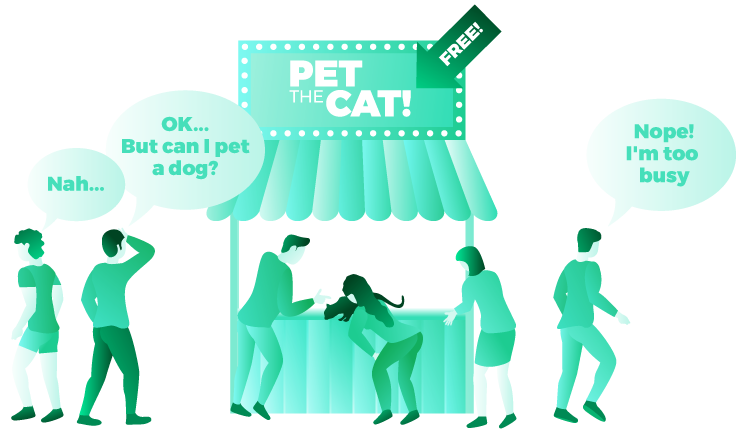
There are generally accepted design principles that guide a visitor toward taking a desired action, such as using contrast to highlight the call-to-action (CTA) button.
Being able to intuitively create a design that guides the viewer toward the desired action is an attractive skill in a graphic designer because it directly impacts business results.
Learning more about CRO can take you even further. Beyond generally accepted design tricks, there is an entire science to CRO that involves split testing and eye tracking. To learn more about the basics of CRO, check out the last segment of our Introduction to Marketing course called “Track, Measure and Adjust”.
Must-know software
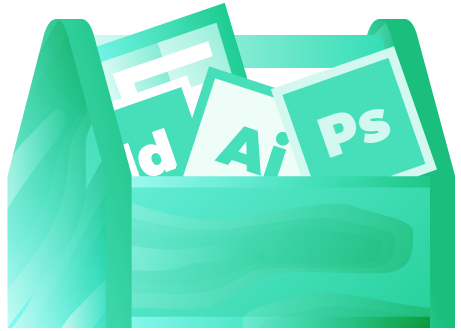
In addition to the skills listed above, graphic designers must also be skilled at using graphic design software to create and manipulate images and text.
The vast majority of graphic design jobs list Adobe Creative Suite products as prerequisite knowledge, so those are the tools we focus on below.
Adobe Photoshop
According to Venngage, 79 percent of job posts require Photoshop skills.
Designers use Photoshop to create and edit raster graphics, which are made up of individual colored pixels mapped on an X-Y axis. Unlike vector graphics, raster graphics cannot scale up without losing image quality. Photographs or scanned images are examples of raster graphics.
If your Adobe Photoshop knowledge is a little rusty – or completely nonexistent – don’t worry. GoSkills has both introductory and advanced Photoshop courses to get your learning on track.
Adobe Illustrator
Adobe Illustrator is a vector graphics editor used to create scalable illustrations such as logos, icons and single-page printed materials like postcards and posters.
Illustrator knowledge is almost as universally required in design jobs as Photoshop, with 74 percent of job posts requiring Illustrator skills.
Need to get your Adobe Illustrator knowledge in shape? GoSkills has introductory and advanced Illustrator courses as well.
Adobe InDesign
Adobe InDesign is Adobe’s desktop publishing software, used to create and lay out publications for print materials, such as posters, magazines and books. It’s used for eBook design as well.
Graphic design jobs
Often, a career in graphic design will not solely consist of just logo creation or just packaging design.
Instead, it will involve a unique combination of two or more of these disciplines. As a graphic designer, the work you create will revolve around the needs of your clients and the solutions that you develop for them.
Of course, if you are particularly talented at a certain type of design, you might decide to specialize.
For example, if you love designing logos, you may be able to find work doing nothing but creating new logos all day. This is more likely to happen if you work as a freelancer since agencies and in-house designers often (but not always) need a more diverse skillset.
In-house vs. agency vs. freelance graphic design jobs
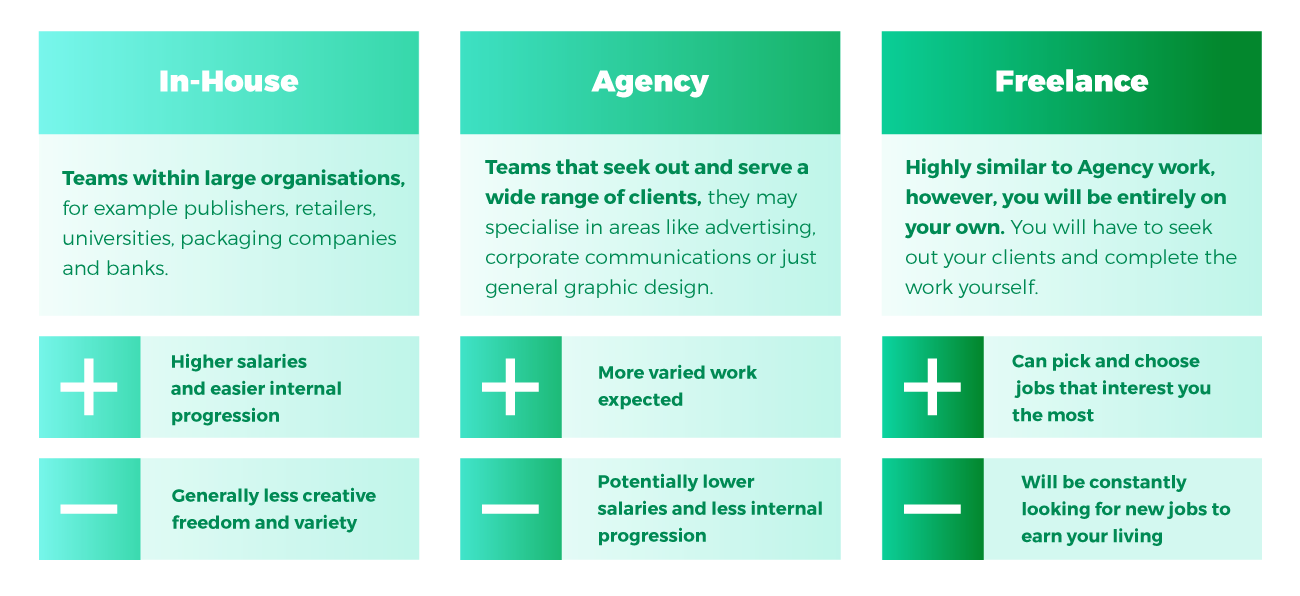
In graphic design, there are generally three career paths: working in-house, working for an agency, or freelancing.
These categories have different pros and cons and will impact your daily work life. Fortunately, all three paths share overlapping skillsets, and it’s totally possible to hop between these worlds if you realize the path you’ve chosen isn’t for you.
In-house graphic design teams create marketing and branding materials internally for large companies.
"In-house" means that an organization has enough work to occupy several people on a full-time basis. However, since designers must adhere to branding guidelines, there is often less creative freedom and projects are less varied.
Agencies that offer graphic design jobs may be focused entirely on graphic design or include design in a suite of other marketing and branding services.
Because agencies pool their resources to service a wide variety of clients, the creative work will likely be more varied as a result. However, agency designers can expect a lower salary and less upward mobility alongside all of the perks.
Freelancers work is similar to agency designers’ work in that their clients are constantly changing and are highly varied. The big difference between the two paths is daily work life.
Working for yourself means that you can set your own schedule and work only with the clients and on the projects you want.
The downside? To pay the bills, you must seek out new clients and be your own best salesperson – a prospect that is exhilarating for some and terrifying for others.
Graphic design career progression and salaries
As in most disciplines, graphic design has a somewhat standard hierarchy to the job titles that you’ll encounter. Here is a breakdown of the most common levels of design jobs on most in-house and agency teams.
Junior Graphic Designer
At the entry level, junior graphic designers can expect to learn a lot about the industry.
While this is a great time to hone your design skills at this level, designers can’t expect to have a lot of creative freedom to pursue their own interests. Instead, they can expect to be doing a lot of typesetting, color correcting, making minor edits to others’ designs or copy, and translating sketched prototypes into digital ones.
Generally, junior graphic designers are supervised by those at the senior level.
Salaries are lowest at this level, with a U.S. national average of $40,640, but the opportunities to learn and grow your design skills are well worth it.
Graphic Designer
The bread and butter of design jobs, mid-level graphic designers do the bulk of the work and generally have between three and seven years’ experience.
This is a great time to build your portfolio, as at least a portion of your work will be on independent projects.
For agency designers, this level typically involves some client interaction which can make the work more stressful on top of already demanding deadlines.
Salaries for graphic designer positions vary wildly and are often commensurate with experience. The national salary average for this position is $51,360.
Senior Graphic Designer
In most cases, a design team will have a few senior graphic designers, who oversee the work of the mid-level and junior graphic designers.
Beyond this basic description, job duties vary from team to team. In some cases, senior graphic designers are the ones championing big campaigns and meeting with clients.
In other cases, senior designers may have simply graduated into the job title and are not doing much – if anything – different than they were when they were a graphic designer. In either case, the title comes with a high degree of creative control over design projects.
Senior graphic designers generally have at least six years’ experience. The average salary in the U.S. is $58,249.
Creative Director
Creative directors are at the pinnacle of their careers and are typically the highest-level members of their department.
In most cases, they start in an entry-level or mid-level design role and work their way up from there. A creative director’s day involves a combination of face-to-face communication with important clients and managing a team of graphic designers.
Creative directors are often promoted into their role, not hired, and the average salary for this position is $133,097.
Graphic design related skillsets and disciplines
If you’re pursuing a career in graphic design, it’s useful to have a few complementary skills from related disciplines. Having a versatile skillset ultimately makes you a more desirable candidate.
With that being said, don’t become a jack of all trades and master of none.
Instead, focus on developing a T-shaped skillset – with basic, foundational skills across a variety of relevant skillsets, and a deep concentration (the vertical part of the T) in just one.
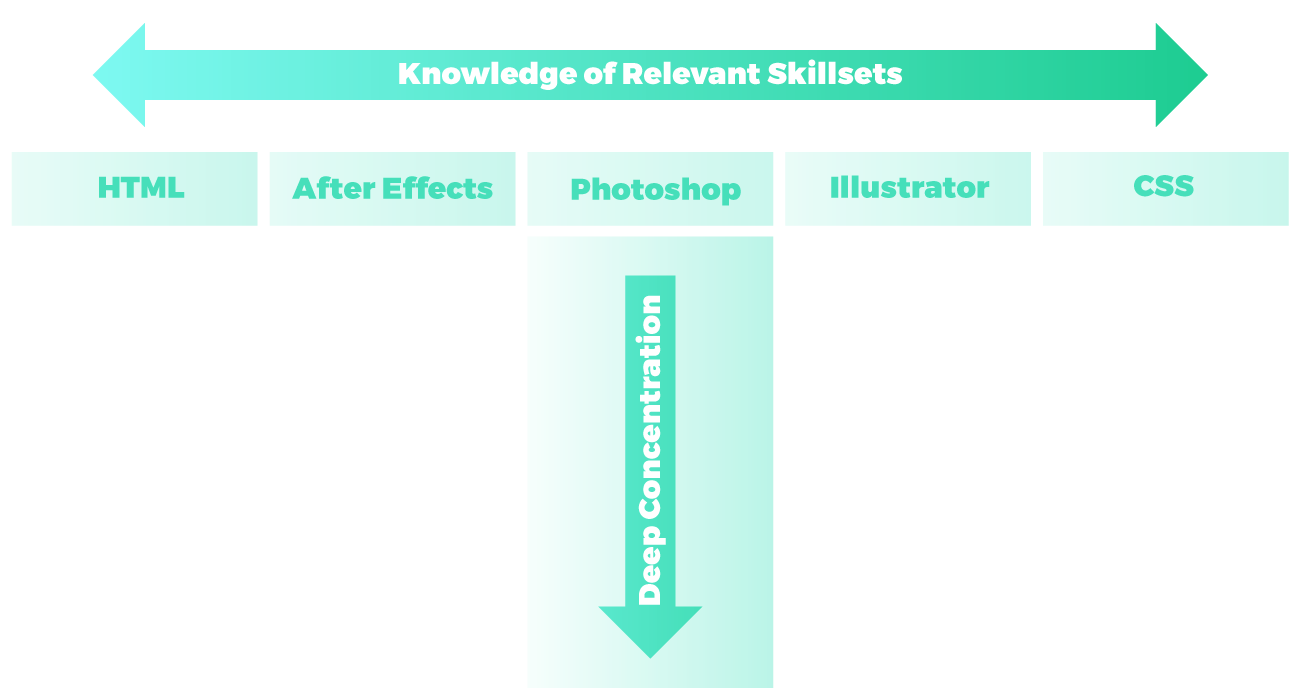
Web design and development
Web designers and developers take the mockups that graphic designers create and turn them into functional websites. There are a variety of coding languages that anyone who develops for the web should be familiar with, from the basics of HTML, CSS and JavaScript to more advanced scripting languages like PHP, Python, Ruby and Java.
There is some blurring between job titles here.
Generally, a front-end designer refers to someone who designs and does little else, a back-end developer refers to someone who codes and does little else, and a full stack designer/developer hybrid refers to someone with the skills to take a web project from start to finish.
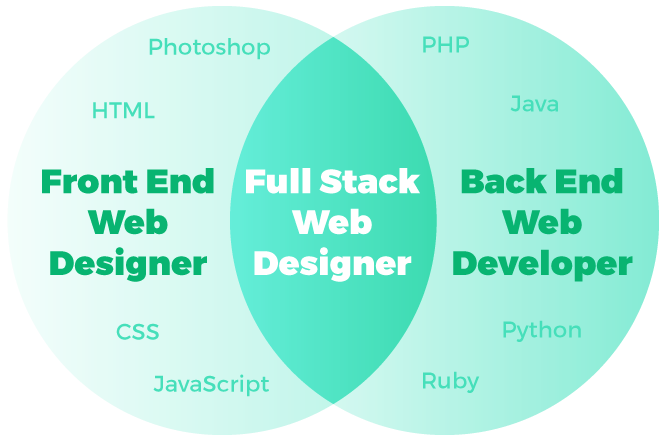
Animation & video editing
Animation as a discipline has a history nearly as long and fascinating as graphic design. While not all the skills overlap, with the rising importance of video on the web, it’s helpful to have at least some basic video editing and animation skills.
The required software will vary based on what you are creating. Final Cut Pro X and Adobe After Effects are popular for video editing while Autodesk Maya is the industry standard for 3D animation rendering.
UI/UX design
As popular a concept as UI and UX are, there is still a lot of confusion around what exactly UI/UX designers do and what the differences are between them.
UX designers are usually involved in the earlier stages of product development, designing a favorable “user experience” for the end consumer.
They may receive a wireframe or prototype of a design, which they then challenge based on the user’s needs. They may perform market research or A/B testing with an early version of the design, as they are aiming to create the best possible workflow for the user.
UI designers (or UI developers, as they are sometimes referred to) create “user interfaces” that connect the needs of the user with the needs of the behind-the-scenes software and databases that make the application function.
For example, UI designers may determine where interactivity or motion is needed in the design to convey a particular idea.
While UI/UX are not commonly listed as required skills in job postings (just 13 percent of postings mentioned them), the job postings that did paid $8,000 more than the overall average.
That’s all folks
Graphic design is an exciting, creative and continually evolving field. If you love the idea of a fast-paced environment where you can solve creative problems and have the opportunity to use Photoshop all day, this might just be the field for you.